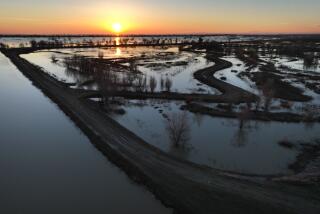California’s vineyards are coming back from the brink of disaster thanks to the winter rains
This spring, it’s all about the “super bloom,” the blanket of wildflowers covering California’s hillsides that has transformed parched desert landscapes into spectacular riots of color. But perhaps more important, it’s also about the state’s vineyards, which are experiencing a comparable replenishment, with a tableau just as colorful and dramatic. Cover crops — mustard, peas, vetch, clover, buckwheat — are weaving a tangled geometry between the vine rows, one of the many signs that in 2017, California’s vineyards — Central Coast vineyards in particular — are coming back from the brink of disaster.
It’s hard to imagine what might have happened to the region without this season’s rains. Record low rainfall levels, coupled with record average temperatures in an age of global warming, had left viticulture from Monterey to Ventura in a low-grade peril. The five-year drought had been so inexorable in its effects, so disruptive to seasonal cycles, that growers were having a hard time imagining what a return to normal would look like. Paso Robles, the Central Coast’s great tourism success story, where vineyard acreage and real estate tracts had ballooned in the last decade, faced the prospect of an abrupt about-face in its growth pattern, as the region confronted one of the most catastrophic water management crises in California history.
Then the rains came. They came early, in short promising bursts, three to five inches in October and November, growing more intense as the months went by, with relative deluges in January and February — 10, 20, 30 inches or more in total, depending on the locale: Nearly all coastal wine regions reported rainfall between 150% and 200% of normal.
“It’s been wonderful,” says Jason Haas of Tablas Creek Vineyard in Paso Robles’ western-most appellation, Adelaida. “The ground is saturated, well levels are better than they’ve been in half a decade. Creeks are running, the reservoirs are nearly full; springs are welling up on our hillsides that we don’t remember seeing for many years.”
While it’s difficult to paint an accurate picture of what’s going on underground, Haas is hopeful that the aquifers, from which the area’s irrigation systems draw water, are being replenished. “Where we are, aquifers recharge easily after a winter like this,” says Haas. “It’s everything we could have asked for.”
For all this optimism, some Central Coast producers are quick to point out that their rainfall totals have been small, compared with the deluges of the North Coast, in Napa and Sonoma. Steve Lohr of J. Lohr Cellars has properties up and down the Central Coast, from Arroyo Seco to Paso Robles.
“It’s good to finally have a break from the drought,” he says, “but it isn’t anything like St. Helena, or in the Bay Area. They’ve had a huge amount of rain up there.”
“You see all this rain and flooding up north, but we’re not getting anything like the percentages that have come to the North Coast,” says Nicholas Miller, whose family owns three large Central Coast vineyards, including Bien Nacido and French Camp. “The perception is that the drought has ended, but that hasn’t been the case for us. It’s been a great winter, but we really didn’t get the capacity we needed.”
Anyone in need of proof can look at the Cachuma Reservoir, just over San Marcos Pass from Santa Barbara, the vast lake that captures moisture from the Santa Ynez Mountains. A year ago, the water level at Cachuma was at just 8% capacity — “an unbelievable crisis,” says Miller. Now, that water level is just a bit less than half. “So we’re at 48%,” says Miller, “which is a reprieve, but it’s 48%, still well below where everyone would like to see it.”
Although the season’s final rainfall figures have yet to be tallied, and their long-term benefits analyzed, growers point to some very obvious immediate effects of the winter’s rains.
First, soils are healthier; they’re less compact, there’s better structure, better nutrient chemistry and best of all, they’re less saline. Soil salinity creates an anaerobic environment that can be inhospitable for useful microbes and that can interfere with nutrient uptake in the vines — in more extreme cases, this can lead to a wine with perceptible levels of salt. This winter, says Peter Cargasacchi of Cargasacchi Vineyard in the Sta. Rita Hills, the soils of the Central Coast “got a proper flushing.”
“There are carbonates, sulfates and chlorides in irrigation water which build up in the soil during periods of drought,” he added. “These have been flushed beneath the rooting zone by rains.”
The increased rainfall will inevitably mean more vigorous shoot and leaf growth, which can lead to imbalance in the vine, unless that growth is kept in check and the plants’ energy is directed toward fruit production. Clusters will inevitably be larger, and less concentrated — but no one’s complaining.
“Drought can lead to quality vintages in the short term,” says Lohr, “but I’d trade that anytime for long-term vine health.”
Perhaps the rainfall’s most useful consequence is that it’s set back a growing season that has been routinely and alarmingly early during the drought years. The great push, beginning with bud break, has commenced among the more precocious varieties, two to three weeks later than the last two dry years. That means a lot less nail biting for growers over frost in early spring, and more even flavor development during the growing season. And harvest, with luck, will no longer begin in mid-August, the hottest part of the summer: good for pickers, and good for grapes, as Cargasacchi says.
“When ripening occurs later during the fall, I think we get less green flavors, and more fruit flavor,” he says. “It’s helpful that the days are shorter and sugar is accumulating less rapidly.”
On the whole, the growers of the Central Coast are cautiously optimistic. “I wouldn’t say this by any means solves things,” says Lohr, “but it gives us a little breathing room.”
ALSO
Wines of the Week: California’s Alexander Valley Cabernets
Along a Los Angeles freeway, the 101 Cider House rules
Make 2017 your best wine year ever
More to Read
Eat your way across L.A.
Get our weekly Tasting Notes newsletter for reviews, news and more.
You may occasionally receive promotional content from the Los Angeles Times.








